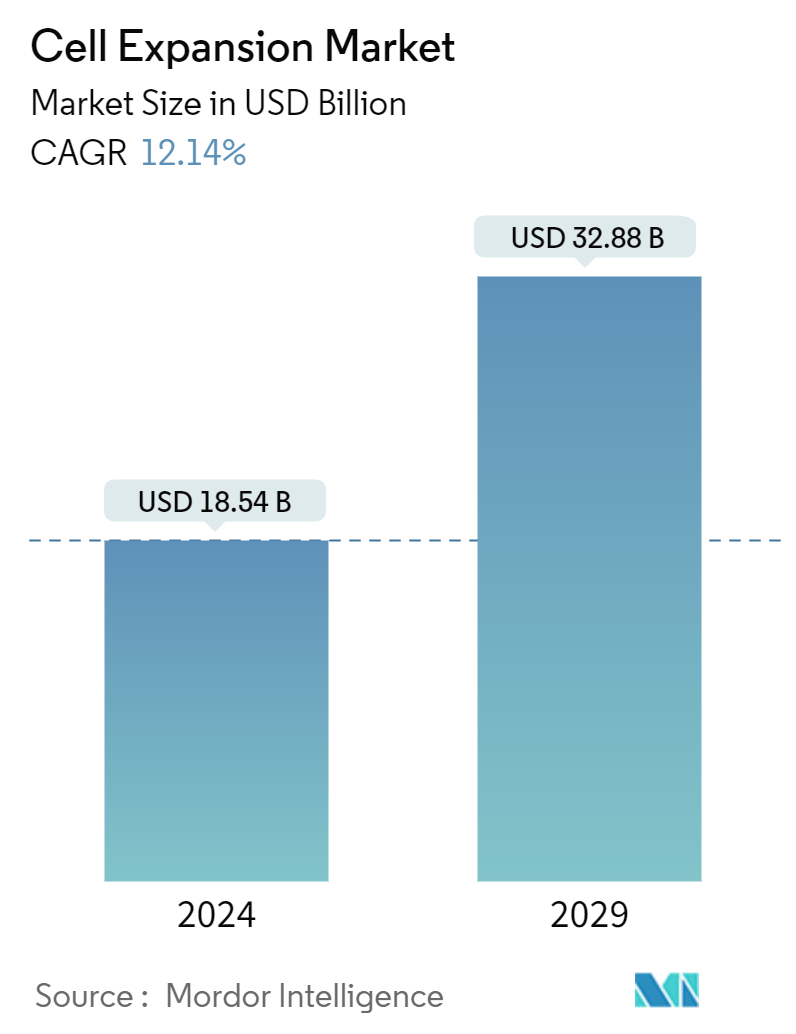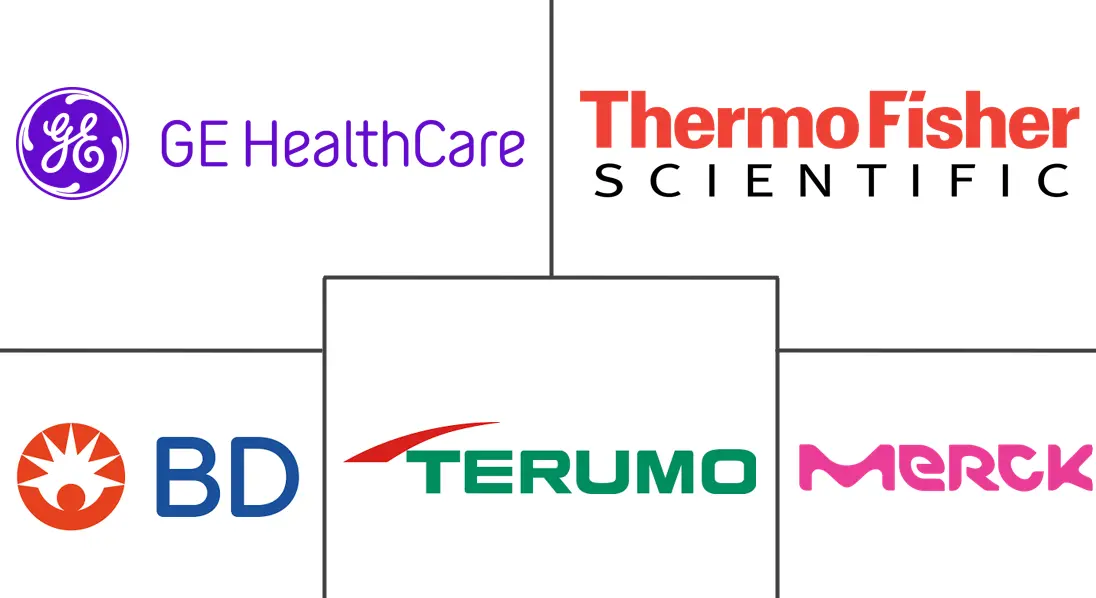Market Size of Cell Expansion Industry

| Study Period | 2019 - 2029 |
| Market Size (2024) | USD 18.54 Billion |
| Market Size (2029) | USD 32.88 Billion |
| CAGR (2024 - 2029) | 12.14 % |
| Fastest Growing Market | Asia Pacific |
| Largest Market | North America |
Major Players
*Disclaimer: Major Players sorted in no particular order |
Cell Expansion Market Analysis
The Cell Expansion Market size is estimated at USD 18.54 billion in 2024, and is expected to reach USD 32.88 billion by 2029, growing at a CAGR of 12.14% during the forecast period (2024-2029).
- The cell expansion market is a pivotal segment within the biotechnology and pharmaceutical industries, integral to the progression and commercialization of cell-based therapies. The market's expansion is driven by a confluence of factors, including the increasing prevalence of chronic diseases, the rising focus on research and development in regenerative medicine, and substantial government investments in cell-based research. Collectively, these factors fuel the growing demand for advanced cell expansion technologies, essential for producing the high volumes of cells required for therapeutic applications.
Advancements in Cell Expansion Technologies
- Technological Innovation: Key advancements in cell expansion technologies, such as automated systems and bioreactors, are significantly enhancing the scalability and efficiency of cell production. These innovations are vital for applications in regenerative medicine, cancer research, and stem cell therapies, where large-scale cell culture is crucial.
- 3D Cell Culture: The growing adoption of 3D cell culture expansion techniques is revolutionizing the industry by providing more physiologically relevant models. These models improve the efficacy and safety of therapeutic products, driving the cell expansion market size.
- Automated Systems: Automated cell expansion systems are streamlining processes, ensuring consistent and high-quality cell production. This automation is particularly beneficial in ex vivo expansion techniques, supporting the production of cell therapies at scale.
- Bioreactors: The development of advanced cell expansion bioreactors is a significant trend, enabling the production of larger cell quantities with enhanced process control and efficiency, which are critical for commercial-scale operations.
Growing Demand for Chronic Disease Treatments
- Chronic Disease Prevalence: The rising incidence of chronic diseases, such as cancer and autoimmune disorders, is a major driver of demand for cell expansion technologies. As the global population ages, the prevalence of these conditions is expected to increase, fueling the need for innovative treatments reliant on large-scale cell production.
- Therapeutic Development: Cell expansion is critical for developing advanced therapies, including CAR-T cell therapies and regenerative medicine. These therapies offer promising solutions for conditions previously deemed untreatable, with ex vivo cell expansion playing a crucial role in their viability.
- Research and Development: Increased investment in research and development is accelerating the adoption of cell expansion technologies. Companies and research institutions are focusing on optimizing cell culture processes to enhance yield and reduce costs, a trend expected to continue as the therapeutic potential of cell-based treatments is realized.
Government Support Fuels R&D in Cell-Based Therapies
- Public Funding: Government investments in cell-based research are a key driver of the cell expansion market. Many countries are recognizing the potential of regenerative medicine and stem cell therapies, leading to increased funding for research and development in these areas.
- Policy Support: Favorable policies and public funding are supporting the establishment of advanced research facilities and the commercialization of innovative cell expansion products. This collaborative environment between academia, industry, and government is crucial in translating research findings into clinical applications.
- Regulatory Guidelines: Regulatory bodies are increasingly providing clear guidelines for the approval and commercialization of cell-based therapies. These guidelines are encouraging further investment in the sector, ensuring that new treatments are safe, effective, and accessible to patients globally.
Challenges in the Cell Expansion Market
- Ethical Concerns: Despite the positive outlook, the market faces ethical concerns related to cell biology research, particularly the use of embryonic stem cells and genetic modifications. These issues present significant moral and regulatory challenges that could impede market growth.
- Process Complexity: The complexity of cell expansion processes, coupled with high costs, underscores the need for process optimization. Ensuring cost-effective and reproducible results is essential for the sustainable growth of the cell expansion market.
- Regulatory Landscape: Navigating the regulatory environment is another challenge, as companies must ensure compliance with stringent guidelines, particularly in the commercialization of cell-based therapies.
Cell Expansion Industry Segmentation
As per the scope of the report, cell expansion deals with the production of daughter cells that arise from a single cell. This process is used in therapeutic development, drug screening, and microlevel research of cells. Presently, cell expansion is widely used to improve transplantation and in the treatment of various diseases such as rheumatoid arthritis, diabetes, and others. Cell expansion also ensures to simplify of the overall task and reduces labor-intensive manual tasks that are associated with the process.
The cell expansion market is segmented by product, application, end-user, and geography. By product, the market is segmented into consumables, reagents, media, & serum, disposables, and instruments. The instruments segment includes cell expansion supporting equipment, bioreactors, and automated cell expansion systems. By cell type, the market is segmented into human cells, and animal cells. By application, the market is segmented into regenerative medicine and stem cell research, cancer and cell-based research, and other applications. By end-user, the market is segmented into biotechnology & biopharmaceutical companies, research institutes, and others. By geography, the market is segmented into North America, Europe, Asia-Pacific, the Middle East and Africa, and South America. The market report also covers the estimated market sizes and trends for 17 countries across major global regions. The report offers the value (in USD) for the above segments.
| By Product | |||||
| Consumables | |||||
| Reagents, Media, & Serum | |||||
| Disposables | |||||
|
| By Cell Type | |
| Human Cells | |
| Animal Cells |
| By Application | |
| Regenerative Medicine and Stem Cell Research | |
| Cancer and Cell-Based Research | |
| Other Applications |
| By End User | |
| Biotechnology & Biopharmaceutical Companies | |
| Research Institutes | |
| Others |
| Geography | ||||||||
| ||||||||
| ||||||||
| ||||||||
| ||||||||
|
Cell Expansion Market Size Summary
The cell expansion market is experiencing rapid growth driven by the increasing prevalence of chronic diseases and a heightened focus on cell-based research and therapies. The rising incidence of cardiovascular diseases and cancer has created a substantial patient pool, presenting significant opportunities for manufacturers in the market. Technological advancements in cell expansion devices, coupled with increased government investments in healthcare, are further propelling market expansion. The consumables segment holds the largest market share, primarily due to the high demand for regenerative medicine production and ongoing research activities in stem cells within biopharmaceutical companies. The constant need for new reagents among end-users and the growing awareness of advanced treatment therapies, such as personalized medicine, are also contributing to the segment's growth.
The Asia Pacific region is poised for significant growth, driven by the rapidly expanding biotechnology and biopharmaceutical industries, along with increased government investments in cancer and stem cell research. Prominent players are focusing on emerging markets, and there is a notable presence of companies engaging in agreements and expansions to strengthen their business operations. Established players are employing various organic and inorganic growth strategies, including new product launches, mergers and acquisitions, partnerships, and collaborations, to enhance their market share. Key companies in this space include Thermo Fisher Scientific, Inc., Becton, Dickinson and Company, Terumo BCT, Merck KGaA, and GE Healthcare.
Cell Expansion Market Size - Table of Contents
-
1. MARKET DYNAMICS
-
1.1 Market Overview
-
1.2 Market Drivers
-
1.2.1 Increasing Incidence of Chronic Diseases
-
1.2.2 Government Investments for Cell-Based Research
-
1.2.3 Increasing Focus on R&D for Cell-Based Therapies
-
-
1.3 Market Restraints
-
1.3.1 Ethical Concerns Regarding Research in Cell Biology
-
-
1.4 Porter's Five Force Analysis
-
1.4.1 Threat of New Entrants
-
1.4.2 Bargaining Power of Buyers/Consumers
-
1.4.3 Bargaining Power of Suppliers
-
1.4.4 Threat of Substitute Products
-
1.4.5 Intensity of Competitive Rivalry
-
-
-
2. MARKET SEGMENTATION (Market Size by Value – USD)
-
2.1 By Product
-
2.1.1 Consumables
-
2.1.2 Reagents, Media, & Serum
-
2.1.3 Disposables
-
2.1.4 Instruments
-
2.1.4.1 Cell Expansion Supporting Equipment
-
2.1.4.2 Bioreactors
-
2.1.4.3 Automated Cell Expansion Systems
-
-
-
2.2 By Cell Type
-
2.2.1 Human Cells
-
2.2.2 Animal Cells
-
-
2.3 By Application
-
2.3.1 Regenerative Medicine and Stem Cell Research
-
2.3.2 Cancer and Cell-Based Research
-
2.3.3 Other Applications
-
-
2.4 By End User
-
2.4.1 Biotechnology & Biopharmaceutical Companies
-
2.4.2 Research Institutes
-
2.4.3 Others
-
-
2.5 Geography
-
2.5.1 North America
-
2.5.1.1 United States
-
2.5.1.2 Canada
-
2.5.1.3 Mexico
-
-
2.5.2 Europe
-
2.5.2.1 Germany
-
2.5.2.2 United Kingdom
-
2.5.2.3 France
-
2.5.2.4 Italy
-
2.5.2.5 Spain
-
2.5.2.6 Rest of Europe
-
-
2.5.3 Asia-Pacific
-
2.5.3.1 China
-
2.5.3.2 Japan
-
2.5.3.3 India
-
2.5.3.4 Australia
-
2.5.3.5 South Korea
-
2.5.3.6 Rest of Asia-Pacific
-
-
2.5.4 Middle East and Africa
-
2.5.4.1 GCC
-
2.5.4.2 South Africa
-
2.5.4.3 Rest of Middle East and Africa
-
-
2.5.5 South America
-
2.5.5.1 Brazil
-
2.5.5.2 Argentina
-
2.5.5.3 Rest of South America
-
-
-
Cell Expansion Market Size FAQs
How big is the Cell Expansion Market?
The Cell Expansion Market size is expected to reach USD 18.54 billion in 2024 and grow at a CAGR of 12.14% to reach USD 32.88 billion by 2029.
What is the current Cell Expansion Market size?
In 2024, the Cell Expansion Market size is expected to reach USD 18.54 billion.

